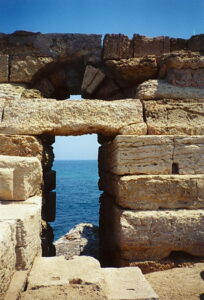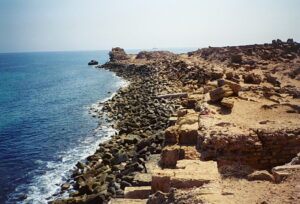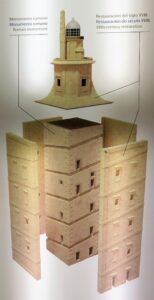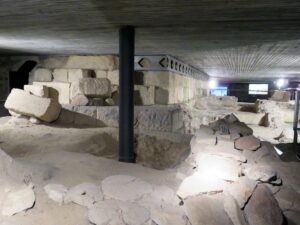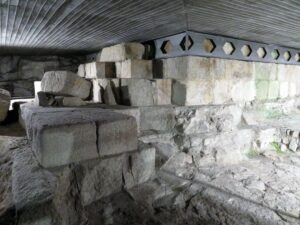As several very good reviews of ancient lighthouses and navigational aids have been provided in the past, our aim is not to add another review here, but just to supply a few pictures made by the author[1]
Except for Alexandria and Rome, lighthouses and beacons are rarely mentioned in ancient literature. The possibly earliest mention of a lighthouse is by Homer (Iliad, 19, 401):
“Like the gleam that sailors catch at sea from a fire burning on a lonely upland farm, when the winds drive them unwillingly from home over the teeming seas, such was the gleam that went up into the sky from Achilles’ ornamented shield.” (transl. Jones, 2003).
The light is thus provided by Achilles’ large and beautiful shield, which is symbolically located today at his tomb near Cape Sigeum.
Homer mentions Pharos Island, but obviously without any lighthouse at that time, as the famous Pharos lighthouse was built much later, around 280 BC.
Also Herodotus seems to tell about a light-emitting-column (Hist. 2, 44):
“I took a ship for Tyre in Phoenicia, where I had learned by inquiry that there was a holy temple of Herakles. There I saw it, richly equipped with many other offerings, besides two pillars, one of refined gold, one of emerald: a great pillar that shone at night;” (transl. Godley, 1920).
Later on, Strabo mentions a watchtower on the Nile delta (Geog. 17, 1, 18):
“After the Bolbitine mouth there runs out to a great distance a low and sandy promontory. It is called Agnu-ceras (or Willow Point). Then follows the watch-tower of Perseus, and the fortress of the Milesians.“ (transl. Bell, 1903).
Strabo does not mention any light emitted by this watchtower.
In addition, Josephus Flavius mentions two towers at the entrance of the port of Caesarea Maritima (Israel) which may have been lit (Jewish Wars, 1, 21 & Jewish Antiquities, 15, 9).
Lighthouses are most emblematic landmarks, but many smaller beacons guided seafarers at the entrance of harbours and estuaries, as described by Strabo in the Rhône delta (France) (Geog. 1, 4, 8) and by Rutilius Namatianus at Vado Ligure (Italy) in 417 AD (De reditu suo, 1, 453):
“Nevertheless, the mouths [of the Rhodanus] still remain difficult of entrance for ships, not only on account of the impetuosity of the river and the silting up, but also of the lowness of the country, so that in foul weather one cannot descry the land even when close to it. Wherefore the Massiliotes set up towers as beacons, because they were in every way making the country their own;” (Loeb Classical Library, 1923).
“Entering on the region of Volaterra, appropriately called “The Shallows,” I thread my way through the deep part of the treacherous channel. At the bow the look-out watches the water beneath and gives directions to the helm beyond, guiding the stern with warning shouts. A boundary on each side marks puzzling narrows by a pair of trees and presents a line of piles hammered in there: to these it is the custom to fix tall laurels easy to see because of their branches and bushy foliage, so that, although the shifting bank of thick mud shows its mass of sea-weed, a clear passage may keep the guiding-signs unstruck.” (Loeb Classical Library, 1934).
Despite the limited number of ancient texts, many pictures were found on coins, reliefs, and mosaics, and around 150 towers found by archaeology are proven or potential lighthouses.
Pictures made by this author concern Leptis Magna (2000), Brigantium (2017), Fréjus (2018) and Cadiz (2023).
The Leptis Magna lighthouse (Libya) is at the eastern end of the northern coastal protection. It was built around 200 AD.
The Tower of Hercules is the ancient Farum Brigantium near A Coruna (Spain). It dates from the 1st c. AD and was renovated in the 18th c. by adding a new external wall as shown on the picture below taken on site. The ancient foundations are still visible underneath the new construction.
Fréjus (France) had at least three navigation beacons: one outside the port on the Ile du Lion de Mer, one at the Triton Monument on the northern side of the port entrance, possibly a lighthouse, and one near the Lanterne d’Auguste on the southern side of the port entrance. These structures date from the 1st c. AD.
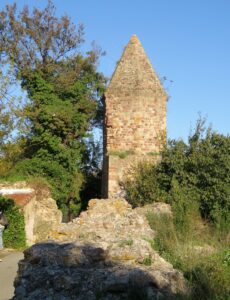
located near a larger structure ‘M7’ that may have supported a lighthouse
(A. de Graauw, 2018).
Cadiz (Spain) is home of the ancient Phoenician harbour of Gadir, later called Gades. Its foundation dates to at least the 9th c. BC. The first settlement was on an island called Erytheia, now connected to the south part of the city and to the long sandy spit called Kotinoussa.
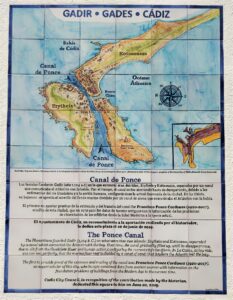
NB: top is East
(A. de Graauw, 2023).
The Cadiz Archaeological Museum features a remarkable graffito of a lighthouse. It seems to be dated from the 4th to the 5th c. AD[2]. However, it is not known where this lighthouse stood and when it was erected. Considering the many shipwrecks on the reefs near the northern side of the Ponce Canal, it should be envisaged that such a lighthouse would be most useful at today’s Castillo de San Sebastian on the south side of La Caleta.
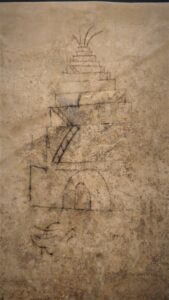
approx. size 40 x 30 cm
(A. de Graauw, 2023).
Notes
[1] The major web site on this subject is: https://www.pharology.eu/ by Ken Trethewey:
TRETHEWEY, K. (2018) “Ancient Lighthouses, and other lighted aids to navigation”, Jazz-Fusion Books, Cornwall, UK.
CHRISTIANSEN, J. (2011) “Les phares et la signalisation maritime à l’époque romaine”, Université Lumière (Lyon II), Mémoire de Master 2, (269 p).
KOUNTOURA GALAKI, E. (2021) “A Light in the Darkness: Monastery Lighthouses in the Aegean Sea and Surrounding Coastal Regions”, in Seasides of Byzantium, Harbours and Anchorages of a Mediterranean Empire, Byzanz zwischen Orient und Okzident 21, Mainz 2021, (p 131-142).
A brief overview is given on: https://en.wikipedia.org/wiki/History_of_lighthouses
[2] BERNAL CASASOLA, D., 2009, “El faro romano de Gades y el papel de los Thynnoskopeia en el Fretum Gaditanum”, in ARIAS, F., FERNÁNDEZ OCHOA, C. and MORILLO, A. (eds.), Torre de Hércules. Finis Terrae Lux. Simposio sobre os Faros Romanos e a Navegación Occidental na Antigüidade (A Coruña, Brigantium 20), (p 85-108).
